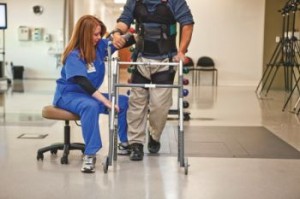 Without exception, a stroke is devastating, not just for the victim, but for the victim’s family as well. Strokes affect roughly one in six people during their lifetime and it is no exaggeration to say that a stroke victim’s life is never quite the same again. Strokes can occur at any age; statistics show that about a third of stroke patients are under 65 years of age.
Without exception, a stroke is devastating, not just for the victim, but for the victim’s family as well. Strokes affect roughly one in six people during their lifetime and it is no exaggeration to say that a stroke victim’s life is never quite the same again. Strokes can occur at any age; statistics show that about a third of stroke patients are under 65 years of age.
There are two types of stroke. The first is the most common and occurs when a blockage in an artery prevents the delivery of oxygen and nutrients to the brain. The second occurs when a vessel ruptures and leaks blood that put pressure on a part of the brain. In both cases, brain cells begin to die and the more time that elapses between the stroke and treatment, the more extensive will be the damage to the brain.
While the type of stroke will dictate the emergency treatment, the damage and rehabilitation are similar.
Rehabilitation after a stroke is crucial, but many therapies offer minimal recovery and patients often are unable to regain full independence.
This isn’t to say that significant, even complete, recovery is impossible. With the right therapy from a chiropractor experience in stroke rehabilitation, stroke victims can recover a great deal of function and independence.
When a stroke patient visits a chiropractor for rehabilitation, the chiropractor will begin with a thorough evaluate. The chiropractor will determine the extent and specific nature of the damage and measure such things as the patient’s muscle strength, range of motion, balance between various sets of muscles, and will analyze the patient’s gait.
The first goal of rehabilitation is to regain muscle control, which may involve mirror work or other specially designed therapies. With mirror work, a weakened limb will place the affected limb in a mirror box and work with the unaffected limb in front of the mirror. Specific brain cells, known as mirror neurons, are tricked into believing the affected limb is moving. In this way, the brain relearns how to control the muscles.
A common problem among stroke patients is a behavioral tendency known as learned non-use. Learned non-use is a reluctance to attempt to use affected limbs and is a problem because the longer a limb is unused, the harder it can become to rehabilitate. Repetitive and deliberate movement can retrain the brain and make using the limb easier and more comfortable.
Once some movement is regained, the focus shifts to regaining as much strength and balance as possible. This is done using a series of prescribed exercises designed to help the patient regain as much function as possible.
Of course, the primary goal of rehabilitation is to reestablish as much normal function as possible. This is possible because of the brain’s amazing ability to rewire itself so that healthy areas take over for the damaged areas in a concept known as neuroplasticity. In cases where complete recovery proves impossible, the patient is taught ways to work around their disability. Either way, the chiropractor and patient work together to ensure the patient is able to regain as much independence as possible.
If you or someone you love has been affected by a stroke, you want the best treatment for rehabilitation possible. You need to call Optimal Life now on (07) 4661 9988 Warwick or (07) 3854 0165 Teneriffe to find out how we can help.
Published by